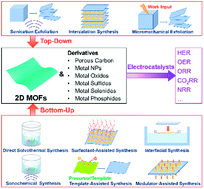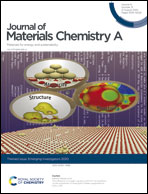Two-dimensional metal–organic framework nanosheets: synthetic methodologies and electrocatalytic applications
Abstract
As a coupled process of reactant diffusion, interfacial adsorption, electrode reaction and charge transfer, the efficiency of electrocatalysis is significantly affected by the rate of each step. The design of high-performance electrocatalysts relies on the optimization of the whole electrocatalysis process. Two-dimensional (2D) nanomaterials have drawn great interest due to their extraordinary properties such as large surface areas, accessible active sites, good thermal and electrical conductivity, confinement effects, etc., indicating that constructing 2D nanostructures can be an effective way to boost the catalytic performance of electrocatalysts. Recently, a series of metal–organic framework (MOF) materials have been developed and have served as promising electrocatalysts due to their merits such as large surface areas, tunable composition, adjustable pore structures, permanent porosity, etc. Combining MOFs with unique 2D structures offers tremendous opportunities for high electrocatalytic performance due to the maximized utilization of surface active sites as well as optimized mass and charge transfer kinetics. However, it remains a great challenge to achieve controlled synthesis of 2D MOF nanosheets with an ultrathin thickness (<10 nm) and large lateral sizes (>1 μm). In this review, the state-of-the-art preparation methods of 2D MOF nanosheets and the design concepts of 2D conductive MOFs are summarized. Synthetic strategies for various 2D MOF derivatives are also presented. Based on these 2D-MOF-based materials, we further discussed their application in various electrocatalysis processes.

- This article is part of the themed collections: Journal of Materials Chemistry A Recent Review Articles and Journal of Materials Chemistry A Emerging Investigators


 Please wait while we load your content...
Please wait while we load your content...